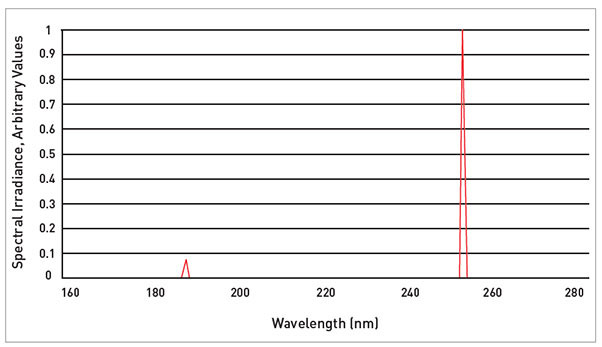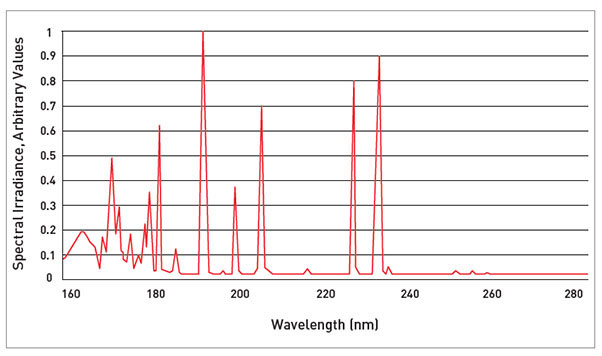UV lamps work by applying power to the lamp electrodes. An electrical arc is generated from ionized gas, or gas mixtures which conduct electricity. Current is limited from the power source to protect the lamp and supply wiring. As the arc temperature rises, mercury in the lamp converts to a gaseous vapor state. Mercury vapor conducts electricity, completing the circuit.
Lamp output in the UV range depends on the amount of mercury and vapor pressure of mercury in the lamp.
Low-pressure, amalgam low-pressure, and medium-pressure lamps are all mercury-based. They differ primarily by electrical excitation and ionization levels of the mercury within the lamp and corresponding internal pressures.
Your application requirements will dictate the selection of lamp technology you choose and will depend on the requirements of each specific site.

Low-pressure lamps are considered to be monochromatic or single-peak output lamps. They operate at about 40°C and have one useful output peak at 254nm. Roughly 40% of the electrical energy imparted into the lamp becomes UV-C energy of the 254 nanometer wavelength.
Low-pressure lamps have the lowest internal pressure and have the lowest power density per unit length of lamp arc.
Like standard low-pressure lamps, amalgam low-pressure lamps are considered to be monochromatic with a significant 254 nanometer output peak. They combine mercury with another element, allowing them to operate at higher temperatures. Approximately 35% of the electrical energy imparted into the lamp becomes UV-C energy at 254 nanometer wavelength.

Medium-pressure lamps have a polychromatic output spectrum and operate at roughly 800°C - 900°C. With an average of 10x the power density per unit arc length, they have significantly higher power compared to amalgam low-pressure lamps. Approximately 12% of the electrical energy that goes into a MP lamp becomes UV-C energy, with a range of 220nm to 280nm.
Given that medium-pressure lamps have a much higher power density than low-pressure lamps, UV systems using medium-pressure lamp technology often have the benefit of fewer lamps and smaller footprint with the trade-off of higher energy consumption.
Have questions? Call us at 1 (888) 220-6118 or complete the form below.